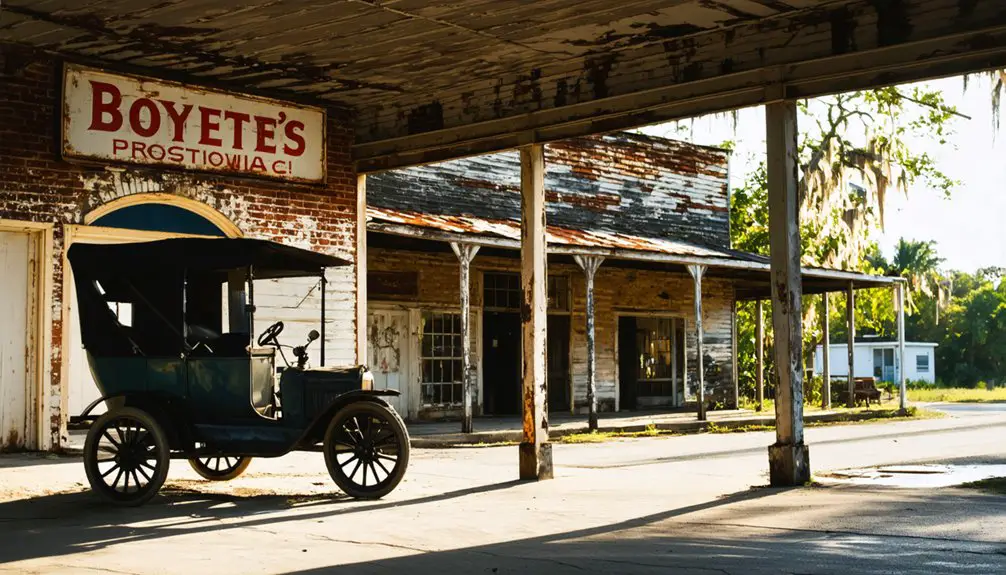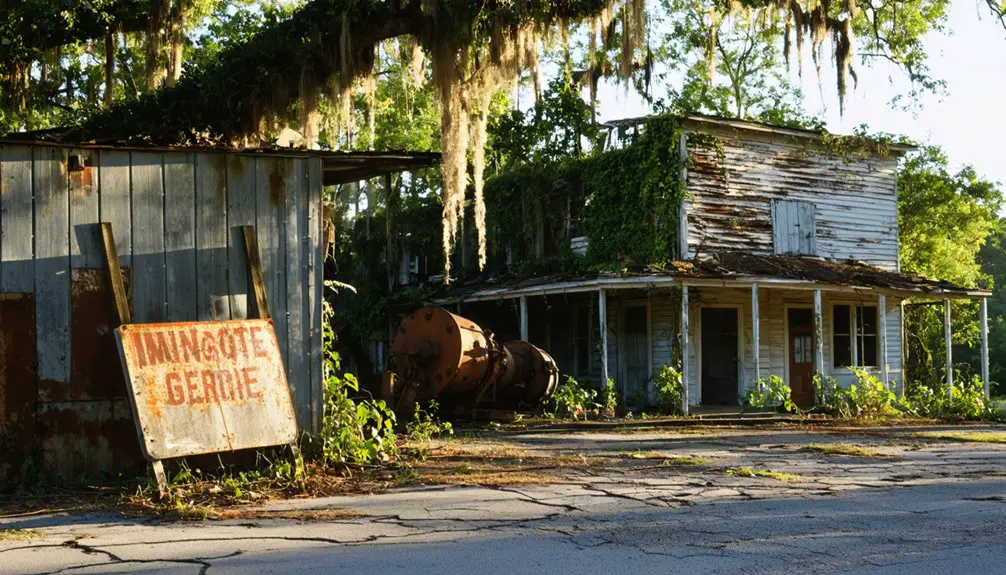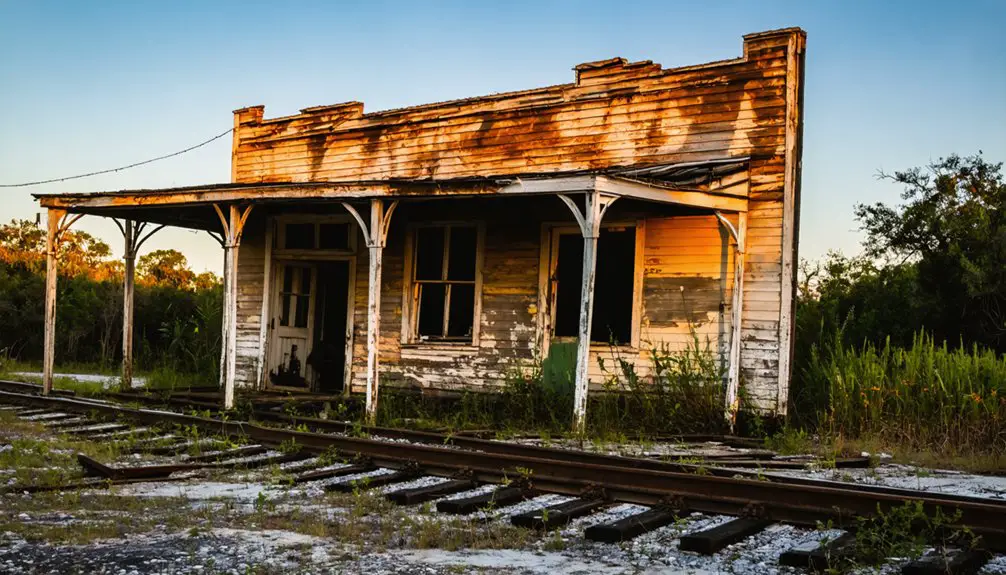You’ll discover Boyette as one of central Florida’s fascinating ghost towns, established in the early 1900s. The settlement thrived after the Seaboard Railroad’s arrival in 1902, growing from 75 residents to 369 by 1930. Under D.L. Thorpe’s influence, the town boasted a sawmill, general store, post office, and Baptist church. While the Great Depression triggered its decline, Boyette’s abandoned structures and agricultural remnants hold countless stories of frontier life.
Key Takeaways
- Boyette was a thriving early 20th-century Florida community that reached its peak population of 369 residents in 1930.
- The town flourished around the Seaboard Railroad line, featuring a post office, general store, sawmill, church, cemetery, and dance hall.
- Agricultural prosperity drove Boyette’s growth, with pineapple plantations, tobacco, cotton, and citrus farming supporting the local economy.
- Economic pressures during the Great Depression forced families to leave, leading to the town’s gradual abandonment.
- Today, only scattered building remnants remain, with historical documentation preserved in Hillsborough County archives and local historical societies.
Origins and Early Settlement
As Florida experienced considerable development in the early 20th century, the small community of Boyette emerged with an initial population of 75 residents by 1911.
You’ll find that early land ownership centered around influential figures like D.L. Thorpe, who controlled much of the town’s economic activity through his sawmill, general store, and post office operations. Like many small Florida settlements such as Hampton Springs, the town initially prospered through its local businesses.
The community’s population growth remained steady, reaching 90 residents by 1918 when the local Baptist church was established.
By 1918, Boyette had grown modestly to 90 residents, marking the same year its Baptist church opened its doors.
During the Florida land boom of the 1920s, Boyette expanded to 100 residents, supporting various businesses including J.N. Connell’s general store. Similar to the nearby community of Viking, the area’s economy was initially driven by pineapple plantations that flourished in the late 1800s.
The Railroad’s Arrival and Impact
When the Seaboard Railroad opened its line through Boyette in 1902, the small settlement’s fortunes changed dramatically. Part of a major railroad expansion connecting Tampa to Bradenton, the line transformed Boyette from an isolated rural outpost into a bustling local hub.
You’d have found a thriving community centered around the railroad depot, where A.E. Wilson served as the local agent. Before the railroad, residents relied on poorly maintained trails for transportation.
The community transformation brought new prosperity, with the establishment of a post office, general store, sawmill, church, cemetery, and dance hall. The Florida Central and Peninsular Railroad had constructed the northernmost segment in 1892, paving the way for Boyette’s development.
Large landowners like C.H. Davis and D.L. Thorpe invested in the area, spurring agricultural growth. The population grew from 75 in 1911 to 100 by 1925, as the railroad enabled farmers to ship their crops and timber to larger markets.
Agricultural Heritage and Economy
During the early 1900s, Boyette’s rich soil attracted prominent landowners like D.L. Thorpe, Davis, Hull, and DeVane. Like today’s agriculture which contributes 200 billion dollars annually to Florida’s economy, farming was the backbone of Boyette’s prosperity.
You’ll find that sustainable practices emerged as farmers diversified their operations, combining fruit growing with sawmills and naval stores. By 1918, the area’s agricultural economy thrived on crop diversity, including tobacco, cotton, sugar cane, and citrus.
The community’s resilience showed through adaptive farming methods and supplemental income sources like moonshining and charcoal production. Early pioneers like the Boyett family were among the first settlers who helped establish the region’s agricultural foundation.
You can trace Boyette’s growth from 75 residents in 1911 to 369 by 1930, reflecting the prosperity that agriculture brought. Family-operated farms dominated the landscape, with both white and African American workers contributing to the agricultural backbone of this Florida community, which supported a network of general stores and essential infrastructure.
Community Life and Religious Institutions
The establishment of Boyette Baptist Church in 1918 marked a pivotal moment in the community’s social development, creating a central hub for both spiritual and civic life. Similar to the stick and mud construction methods seen in historic buildings of the American South, the church incorporated local materials and architectural elements of the era. Much like how the Masonic lodge in Ellaville served as a gathering space, religious institutions were vital to small Florida towns.
You’d find religious gatherings intertwined with daily routines, fostering community cohesion among the mainly white population of farmers and fruit growers. The church worked alongside the general store and post office to strengthen social bonds during Boyette’s peak years in the 1920s.
- Sunday worship services brought families together from scattered rural homesteads
- Church leaders often collaborated with prominent landowners like the Davis and Thorpe families
- Religious activities provided moral guidance and social structure for the population of 369
- The church supported residents through economic ups and downs
- Social meetings at the church helped maintain community identity despite isolation
Peak Years and Development

You’ll find that Boyette’s economic growth accelerated after the Seaboard Railroad established service in 1902, connecting local farmers to broader markets.
The railroad’s presence, overseen by agent A.E. Wilson, enabled efficient transport of agricultural products, particularly fruits grown in the region’s rich soil.
Similar to the early structures of North Carolina, which featured mud and stick chimneys, these pioneer buildings used local materials for construction.
Like the Hampton Springs Hotel which burned down in 1954, many early Florida developments faced challenges that affected their long-term survival.
Railroad-Driven Economic Growth
Seaboard Air Line Railroad’s 1902 extension through Boyette marked the beginning of rapid economic transformation in this small Florida community. The railroad expansion catalyzed unprecedented growth, connecting Boyette to major markets in Tampa and Bradenton.
You’d have witnessed economic diversification as timber operations, naval stores, and citrus agriculture flourished alongside the rail line.
- A.E. Wilson served as railroad agent while D.L. Thorpe operated a bustling sawmill and general store
- Local entrepreneurs established retail businesses catering to railway travelers
- Naval stores production emerged as a crucial revenue stream
- Postal services synchronized with train schedules to improve communication
- Agriculture, particularly citrus, gained access to broader markets
The railroad’s presence spurred population growth from 75 residents in 1911 to 369 by 1930, transforming Boyette into a thriving commercial hub.
Agricultural Trade Development
Building upon the railroad’s momentum, agricultural trade in Boyette expanded dramatically between 1910 and 1930.
You’d find diverse crop yields flourishing in the area, from citrus groves with twenty-foot-tall orange trees to thriving truck farms producing beans and tomatoes. Local trade networks centered around general stores and the post office, where farmers exchanged goods and information.
As the population grew from 75 to 369 residents, prominent farming families like the Davis, Thorpe, Hull, and DeVane clans established robust agricultural operations.
They’ve taken advantage of natural springs and sinkholes for cost-effective irrigation, maximizing their harvests. The expanding road system, anchored by State Road 54, connected you to broader markets, while the railroad provided crucial distribution channels for your produce to reach regional consumers.
Transportation Networks and Trade Routes
When the Seaboard Railroad Line arrived in Boyette in 1902, it transformed the town’s economic landscape by replacing slow-moving stagecoach routes with efficient rail transportation.
You’ll find this transportation evolution marked a pivotal shift in trade dynamics, connecting Boyette to Tampa’s bustling port and major Florida cities like Gainesville and Orlando.
The rail network revolutionized how farmers shipped their citrus crops and connected rural producers to urban markets.
Rail transport transformed agriculture by linking rural citrus farmers to city markets, revolutionizing Florida’s farm-to-market distribution system.
- Depots and stations became central hubs for passenger travel and freight exchange
- Rail lines integrated with existing stagecoach roads near the St. John’s River
- Trade routes stretched from Palatka to Tampa, creating crucial commercial corridors
- Transportation infrastructure attracted new settlers and businesses
- Railroad connections enabled swift delivery of perishable goods to distant markets
The Path to Abandonment

Despite Boyette’s initial growth through rail connections, the town’s journey toward abandonment began in the early 1920s. While the Florida land boom briefly pushed the population to 100, economic shifts soon triggered the town’s decline.
By 1930, even with a peak population of 369 residents, you’d have witnessed the start of major demographic changes as sawmills closed and agricultural challenges mounted.
The Great Depression dealt another blow, pushing families to seek opportunities elsewhere. Environmental pressures, including floods and soil degradation, made farming increasingly difficult.
You’d have seen the town’s essential institutions fade away – the post office, general store, and Baptist church couldn’t sustain themselves as younger generations left. Without commercial enterprises or public investment, Boyette’s remaining residents gradually dispersed, leaving the once-promising settlement to fade into history.
Historical Records and Documentation
You’ll find detailed railroad maps from 1911 preserved in Hillsborough County archives that confirm Boyette’s layout and its essential railway connections.
The Baptist Church‘s founding in 1918 left behind important records documenting the town’s religious life and social development, including membership rolls and meeting minutes.
While few photographs of early Boyette remain, the existing images provide visual evidence of the sawmill, general stores, and railroad depot that once formed the heart of this frontier community.
Railroad Maps Documentation
Through extensive historical documentation, Boyette’s railroad presence can be traced using various map collections and archives. The 1910 sectional map of Florida shows Boyette within Hillsborough County’s rail network, while 2009 maps reveal its continued rail connections.
You’ll find railroad maps and archival resources at the University of North Florida’s Thomas G. Carpenter Library and the Florida Center for Instructional Technology.
- The 1910 map uses distinct colors to identify different railroad companies operating near Boyette.
- Seaboard Air Line Railroad’s expansion connected Boyette through the Sarasota Subdivision lines.
- Pastmaps.com offers 20 historic maps focusing on Boyette’s development.
- Corporate records from railroad companies detail line construction and acquisitions.
- Both color and black-and-white maps from 2009 document modern rail infrastructure.
Church Records Preservation
While railroad maps chart Boyette’s physical development, church records offer intimate glimpses into the community’s spiritual and social fabric. Through church documentation efforts, you’ll find founding records from the early to mid-1800s, though exact dates often blend oral history with written accounts.
These preserved documents reveal marriage registries, burial records, and membership lists that trace the town’s earliest families.
You’ll discover that church record preservation faces significant challenges, as many original volumes have been lost to time, relocation, or natural disasters.
Local historical societies are working to digitize remaining records and photograph adjacent cemeteries, where marked and unmarked graves tell additional stories.
These preservation initiatives help piece together Boyette’s past, combining cemetery data with surviving church documents to paint a clearer picture of this ghost town’s community life.
Early Photographic Evidence
Early photographic evidence from Boyette centers on a remarkable 1910 image that captured the town’s essential railway infrastructure, including its depot buildings, section houses, and produce freight station.
The black-and-white photographic techniques of the era preserved crucial details about this once-thriving community, creating a visual storytelling archive that you can still explore today.
- Railroad tracks and depot buildings stand as proof of Boyette’s role as a bustling shipping point
- Section houses reveal the architectural style and community layout during the town’s peak
- Freight facilities highlight the importance of agricultural commerce
- Infrastructure placement shows how the town was organized around its railway lifeline
- Building configurations demonstrate the era’s construction methods and spatial planning
These historic photographs now serve as irreplaceable documentation of Boyette’s vanished structures and lost way of life.
Remnants and Lost Structures
Today’s visitors to Boyette encounter scattered remnants of what was once a vibrant Florida settlement, with large foundations suggesting multiple attached buildings that served both residential and industrial purposes.
You’ll find evidence of architectural decay throughout the site, where wooden structures have collapsed, leaving only nails and fragments behind. Nature’s environmental reclamation is evident as trees and vegetation slowly consume old brick walls, metal pieces, and concrete foundations.
Along the former railroad grade, you can trace the path where the Florida Southern Railroad once connected Boyette to the outside world.
The site’s industrial heritage reveals itself through scattered metal fragments and turpentine-related artifacts, while domestic items like old stoves and furniture pieces hint at the daily lives of former residents.
Legacy in Florida’s Rural History

You’ll find Boyette’s agricultural heritage in the scattered fruit groves and farmland that once defined this bustling rural community.
The railroad’s influence remains visible through old track beds and infrastructure that supported the town’s growth as a maintenance center and water stop in the early 1900s.
The memories of Boyette’s thriving past live on through descendants of original families like the Davis, Thorpe, Hull, and DeVane clans who still share stories of the town’s role in Florida’s rural development.
Agricultural Roots Still Visible
Throughout Boyette’s evolution from a modest settlement of 75 residents in 1911 to a thriving agricultural community of 369 by 1930, the town’s farming roots shaped its identity and economic foundation.
Today, you’ll find tangible reminders of this agricultural heritage across the landscape, from historic citrus cultivation sites to remnants of sharecropping practices that once dominated the region.
- Original sawmills and naval stores that supported the farming economy
- Boyette’s Grove, now an agritourism destination featuring vintage 1940s citrus equipment
- 100-acre farm plots that reflect traditional family farming patterns
- Former cotton fields that shifted to tobacco after the boll weevil crisis
- Historic general stores and fruit packing facilities that served the farming community
Railroad Impact Lives On
When the Seaboard Railroad line arrived in Boyette in 1902, it transformed this small farming settlement into an essential transportation hub, marking a pivotal shift in the town’s economic trajectory.
You’ll find railroad nostalgia preserved in the remnants of the town’s infrastructure, including the 1910 depot and the Jolly Family House that still stands near the old tracks.
Though Boyette’s economic resilience was tested by devastating freezes in 1894-95 that decimated local citrus crops, the railroad’s legacy endures in the region’s historical narrative.
The tracks that once carried crops to market and brought supplies to local farmers now serve as silent witnesses to an era when rail connections meant survival for rural communities.
Today, these physical reminders tell the story of how railroads shaped Florida’s agricultural development and rural settlement patterns.
Community Memory Endures Today
Despite its quiet streets today, Boyette’s vibrant community spirit lives on through preserved records and local memories.
Historical narratives showcase the community resilience that defined this rural Florida settlement, where a diverse population of 369 residents built their lives by 1930. You’ll find their stories woven into census records, business directories, and preserved documents that paint a rich tapestry of early 20th-century life.
- Church gatherings at Boyette Baptist brought neighbors together since 1918
- General stores owned by D.L. Thorpe and George Robb served as social hubs
- Fruit growers and sawmill workers shaped the local economy
- African American residents contributed to the community’s cultural fabric
- Local families maintained strong ties through shared agricultural traditions
Frequently Asked Questions
What Happened to the Residents of Boyette After the Town’s Decline?
You’ll find the former residents scattered to nearby growing towns, following economic shifts that forced relocation patterns toward urban centers with better job prospects and social infrastructure.
Were There Any Notable Crimes or Incidents in Boyette’s History?
While there aren’t many documented unsolved mysteries from old Boyette, you’ll find the 2017 Boyette crime spree stands out, when William Boyette’s violent rampage terrorized the region through multiple states.
What Natural Disasters, if Any, Affected Boyette During Its Existence?
Despite Florida’s history of over 120 major storms, you won’t find records of hurricane impact or flood damage specifically affecting Boyette. The town’s challenges stemmed from economic shifts rather than natural disasters.
Did Any Famous People Ever Live in or Visit Boyette?
You won’t find any famous visitors in Boyette’s history. While local historical figures like D.L. Thorpe and George Robb were important to the community, they never achieved wider recognition beyond the region.
What Was the Highest Recorded Population of Boyette?
Ever wonder what peak population growth looks like? According to census records, you’d have found 369 people living there in 1930, with an almost even split between men and women.
References
- https://afamwilsonnc.com/2025/01/25/event-signal-boost-the-history-of-boyette-slave-and-school-house/
- https://theforgottensouth.com/ghost-town-ellaville-florida-history-governor-drew-mansion/
- https://en.wikipedia.org/wiki/List_of_ghost_towns_in_Florida
- https://theforgottensouth.com/boyette-slave-school-north-carolina/
- https://pbase.com/daveb/hills_co_fl
- https://www.youtube.com/watch?v=TxBONhwNi1k
- http://hillsborough.wateratlas.usf.edu/upload/documents/HILLSBOROUGH_COUNTY_Historic_Resources_Excerpts_Boyette.pdf
- https://www.tiktok.com/@averym0995/video/7464272006737988910
- https://www.ospreyobserver.com/2021/04/all-aboard-the-train-comes-to-hillsborough-county/
- https://en.wikipedia.org/wiki/Sarasota_Subdivision



